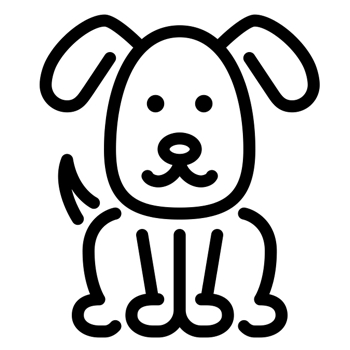Sealydale Terrier

A rare and unusual hybrid, the Sealydale Terrier is a mixture of the long-limbed Airedale Terrier and the good-natured Sealyham Terrier. As both parent breeds are not particularly popular, it is little wonder that the Sealydale Terrier is not a common sight. In fact, some experts will actually debate their current existence!
Far shorter than their Airedale parent, the Sealydale Terrier is a medium-sized dog. Their characteristic ears are triangular in shape and flop forward endearingly. They have a wiry coat that may have a slight wave to it and can be seen in a number of colours, including white, black and tan.
About & History
Interestingly, most experts concur that the first Sealydale Terriers were bred in South Africa for the purpose of keeping the local vermin levels low. Historical records of their existence date back to the early and mid 1900s but since World War Two it has proven harder to come by this uncommon cross-breed.
The Airedale Terrier
The Airedale Terrier is a fine specimen of a dog and is the tallest Terrier of them all – one of the main reasons it is referred to by some as The King of the Terriers. It is widely believed that they originated in the Aire Valley, West Yorkshire in England, which explains their rather curious name.
The breeds used in their creation include the Otterhound and the now extinct Black & Tan Terrier. They have always been used as hunting dogs and were highly prized for their ability to work on both land and water; a rarity for a terrier. As well as this, they would have been kept as guard dogs, particularly by farmers. Not long after their creation, the Airedale Terrier was exported all around the world to countries including America, South Africa and India where they were kept as both working dogs and companion animals.
The Airedale Terriers’ claim to fame is that they were messenger dogs during the First World War and this is when they earned a great deal of respect. Since then, however, the breed has been in less demand and is rarely seen today, even in its homeland of England.
The Sealyham Terrier
The Sealyham Terrier is a lesser known Terrier that also originated in the UK. With their long skulls and necks that seem to be able to extend on demand, they are capable of hunting deep into small spaces and burrows, picking up on distant scents that others cannot.
Their name can be attributed to ‘Sealyham House’, the home of a Captain John Tucker-Edwardes who was determined to create a Terrier that would make a good hunter and would be small and white, distinguishing itself from its prey and avoiding any hunter errors when shooting!
While records are limited, the breeds thought to have been used in the pursuit of this new dog include the Corgi and the Dandie Dinmont Terrier. Although practically unheard of today, the breed enjoyed great success at the start of the 20th century and was much-loved by celebrities and royals alike.
Appearance
A medium-sized dog that retains the long muzzle and neck of its parents, the Sealydale Terrier is not classically attractive. It has a rather flat skull, from which protrude its pendulous ears, hanging to the front of its face. Its neck is long and thick while its body is quite compact and muscular. Their straight limbs are medium in length and they should have a good abdominal tuck-up. Their quirky tail stands erect from their rump and is stocky at the base.
Never reaching the staggering heights of the Airedale, the Sealydale Terrier measures between 38cm and 43cm and will weigh from 15kg to 18kg. The coarse coat of the Sealydale Terrier can have a slight wave to it. They should be groomed in a particular fashion, leaving their fur long on their face and undercarriage. Their fur is relatively short in other places, such as on their ears and tail. Several coat colours and colour combinations are possible, though many are white with patches of either brown or black.
Character & Temperament
With both parents being bred as workers, it is little wonder that the Sealydale Terrier can be tenacious and switched on. As is true of many terriers, they can be rambunctious and rowdy, often getting over-excited and barking for little to no reason. Many are independent and strong-willed, requiring a perseverant owner to ensure they do not get out of hand and understand their role in the household.
Kind and gentle with their family, most Sealydale Terriers thoroughly enjoy being around people of all ages and will form strong attachments with their owners, including the children. However, they must always be supervised around little ones, as they are not the most tolerant of dogs and do not enjoy being pulled about. They generally like to be in the company of other dogs but their prey drive is too high to be able to trust them around smaller pets, such as rabbits and cats.
The Sealydale Terrier is known for making a wonderful watch dog and will constantly be on guard when at home, listening out for new arrivals. They will usually warn away potential intruders with their incessant barking and are unlikely to attack if provoked.
Trainability
As the Sealydale Terrier can be strong-minded, they do best with an experienced trainer who is not lacking in patience. Their stubbornness can often be overcome with plenty of positive reinforcement techniques and they do have the potential to do well thanks to their innate intelligence. These dogs are naturally good at both hunting and guarding, so need little training when it comes to these tasks.
Health
As there are so very few Sealydale Terriers in the world, a huge emphasis must be placed on their health when breeding. If breeding F1s (breeding them from their pedigree parents rather than from Sealydale Terriers), breeders must look to their kennel club to ensure they are using dogs which have passed all of the relevant health tests. Failing to do this could result in a critically unhealthy population in a short space of time.
Atopic Dermatitis
Atopic dermatitis can be one of the most frustrating conditions that a dog can develop as it causes chronic itchiness and sore skin, it can be tricky to determine the trigger and is rarely curable. Though dogs can become itchy anywhere, the face, belly, groin and paws are most often affected.
Atopy can occur secondary to many allergens including house dust mites, pollen and grass. The majority of dogs will be allergic to more than one thing, making it even more difficult to get a handle on the condition. Treatment options are being developed all the time though despite this, many find that they struggle to keep symptoms at bay all year round.
Eye Problems
The Sealydale Terrier can be prone to a number of ocular conditions, including glaucoma, lacrimal punctal aplasia and lens luxation. Any symptoms a dog develops that involve the eye (or eyes) must be taken seriously and veterinary treatment should be sought without delay. Oftentimes, a second opinion from an ophthalmologist will prove useful.
Exercise and Activity Levels
As each parent breed has quite different exercise demands, the Sealydale Terrier’s activity levels will vary from one dog to another. In general, a good 45-minute walk a day, as well as time spent sniffing, playing and training is enough for most.
The Sealydale Terrier may well turn to grass digging and backyard barking if they are left out in the garden with little to do. They prefer to exercise alongside people and/or other dogs.
Grooming
The distinctive coat of the Sealydale Terrier is not to everyone’s liking and typically requires the help of a professional groomer to look its best. At a minimum, they should get groomed a couple of times a year. Owners should get the breed accustomed to brushing their longer fur with a wire brush and to cleaning their facial fur after eating. Their pendulous ears require cleaning, usually on a weekly basis.
On top of this, owners should strive to brush their teeth at least every other day, to help prevent periodontal disease. If walked on pavement, they will generally not require regular claw trims though may need their dew claws to be cut back every few months.

